
Jupiter I
Nothing endures but change.
- Heraclitus
|
Table of Contents |
|
Io Introduction
|
|
Parent Planet |
|
Io Science |
Io orbits closer to Jupiter's cloud tops than the moon does to Earth. This places Io within an intense radiation belt that bathes the satellite with energetic electrons, protons, and heavier ions. As the Jovian magnetosphere rotates, it sweeps past Io and strips away about 1,000 kilograms (1 ton) per second of volcanic gases and other materials. This produces a neutral cloud of atoms orbiting with Io as well as a huge, doughnut shaped torus of ions that glow in the ultraviolet. The torus's heavy ions migrate outward, and their pressure inflates the Jovian magnetosphere to more than twice its expected size. Some of the more energetic sulfur and oxygen ions fall along the magnetic field into the planet's atmosphere, resulting in auroras. Io acts as an electrical generator as it moves through Jupiter's magnetic field, developing 400,000 volts across its diameter and generating an electric current of 3 million amperes that flows along the magnetic field to the planet's ionosphere.
Io Discoveries
On January 7, 1610 Galileo Galilei observed three pinpoints of light strung out in a line next to Jupiter. The next evening, these stars seemed to have moved the wrong way, which caught his attention. Galileo continued to observe the stars and Jupiter for the next week. On January 11, a fourth star (Ganymede) appeared. After a week, Galileo observed that the four stars never left the vicinity of Jupiter, appeared to be carried along with the planet, and changed their position with respect to each other and Jupiter. Finally, Galileo determined that what he was observing were not stars, but planetary bodies that were in orbit around Jupiter. This discovery provided evidence in support of the still heretical Copernican solar system and showed that everything did not revolve around the Earth.In 1676 a Danish astronomer Ole Romer was able to make the first accurate measurement of the speed of light by using eclipse timings of the Galilean satellites with Jupiter's shadow. Another discovery was made by Pierre-Simon de Laplace during the late 1700s when he deduced that the orbital periods of Io, Europa, and Ganymede are nearly in a perfect 1:2:4 ratio. In 1920 this knowledge paved the way for the first estimate of the satellites' masses within an accuracy of 20%. Finally in 1979, the Voyager spacecraft flew past the Jovian system, took high-resolution pictures of the moons, and conducted experiments that provided the first accurate measurements of the moon's dimensions and mass. These in turn were used to calculate the mean density of Io (3.5 g/cm3), Europa (3.0 g/cm3), Ganymede (1.9 g/cm3), and Callisto (1.8 g/cm3).
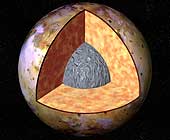
|
Left: This cutaway illustration shows the possible internal structure of Io. The interior characteristics of the moon are inferred from gravity field and magnetic field measurements by the Galileo spacecraft. Io has a metallic (iron, nickel) core (shown in gray) drawn to the correct relative size. The core is surrounded by a rock shell (shown in brown). Io's rock or silicate shell extends to the surface. [more] |
| Io Statistics | |
|---|---|
| Discovered by | Simon Marius & Galileo Galilei |
| Date of discovery | 1610 |
| Mass (kg) | 8.94e+22 |
| Mass (Earth = 1) | 1.4960e-02 |
| Equatorial radius (km) | 1,815 |
| Equatorial radius (Earth = 1) | 2.8457e-01 |
| Mean density (gm/cm^3) | 3.55 |
| Mean distance from Jupiter (km) | 421,600 |
| Rotational period (days) | 1.769138 |
| Orbital period (days) | 1.769138 |
| Mean orbital velocity (km/sec) | 17.34 |
| Orbital eccentricity | 0.004 |
| Orbital inclination (degrees) | 0.040 |
| Escape velocity (km/sec) | 2.56 |
| Visual geometric albedo | 0.61 |
| Mean surface temperature | -143°C |
| Magnitude (Vo) | 5.02 |
- Io Fly Around.
- Io Rotation with Enhanced Colors.
- Animation of Babbar Patera.
- Io Rotation Movie.
- Io in Rotation/Volcanoes Erupting.
- Pan of Io.
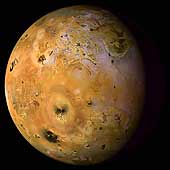 Color Image of Io
Color Image of Io
This color image of Io was created by combining the color
channels of the low resolution USGS Voyager controlled color mosaic with
Tayfun Oner's high resolution Galileo mosaic. The brown, orange areas are
probably covered by sulphur or a mixture containing sulphur. The light areas
may be sulphur dioxide snow and the pock-marks are mostly volcanic
calderas up to 200 kilometers (124
miles) across. Mountainous regions exist near both poles, with some
features rising 8 kilometers (5 miles) or more above their surroundings.
(Courtesy A.Tayfun Oner)
 Io Feature Map
Io Feature Map
This is the highest resolution color global mosaic of Io. It was created by
combining the color channels of the low resolution USGS
controlled color mosaic with the high resolution B&W controlled USGS
mosaic. It was then projected to an ortographic projection
centered at 0 degrees latitude and 315 degrees longitude.
(Courtesy A.Tayfun Oner)
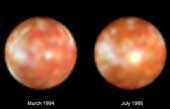 Hubble Discovers Bright New Spot on Io
Hubble Discovers Bright New Spot on Io
This pair of Hubble images of Jupiter's volcanic
moon Io shows the surprising emergence of a 320-kilometer (200-mile)
diameter, large yellowish-white feature near the center of the moon's
disk (photo on the right). Scientists suggest the spot may be a new
class of transient feature on the moon. For comparison, the
photo on the left was taken in March 1994 before the spot emerged,
and shows that Io's surface had undergone only subtle changes since it
was last seen by the Voyager 2 probe in 1979.
The new spot in the July 1995 Hubble image replaces a smaller whitish
spot seen at about the same location in the March 1994 image. "The new
spot surrounds the volcano Ra Patera, which was photographed by Voyager,
and is probably composed of material, probably frozen gas, ejected from
Ra Patera by a large volcanic explosion or fresh lava flows,"
according to John Spencer of Lowell Observatory in Flagstaff, Arizona.
(Credit: J. Spencer, Lowell Observatory/NASA)
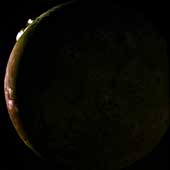 Io's Volcanic Plumes
Io's Volcanic Plumes
Voyager 2 took this picture of Io
on the evening of July 9, 1979, from a range of 1.2 million kilometers
(745,700 miles). On the limb of Io are two blue volcanic eruption
plumes about 100 kilometers (62 miles) high. These two plumes were first
seen by Voyager 1 in March 1979 and are designated Plume 5 (upper) and
Plume 6 (lower). They apparently had been erupting for a period of at
least four months and probably longer. A total of six plumes were seen
by Voyager 2, all of which were first seen by Voyager 1. Plume 1, the
largest volcano viewed by Voyager 1, was no longer erupting when Voyager
2 arrived. Plume 4 was not viewed on the edge of Io's disc by Voyager 2
and, therefore, it is not known whether it was still erupting.
(Copyright Calvin J. Hamilton)
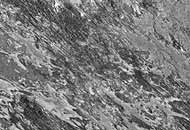 Close-Up of Io's Surface
Close-Up of Io's Surface
This image is the highest resolution image ever taken of Io.
The resolution is 5.2 meters (18 feet) per picture element.
Galileo viewed the surface obliquely, tilted 72 degrees from straight
overhead. Illumination is from the lower right, but the topographic
shading is difficult to see because of the strong contrasts in
brightness of the surface materials. The bright areas are generally
higher in elevation than adjacent dark areas. The surface appears to
have been eroded by an unknown process, in places exposing layers of
bright and dark material. Evaporation of solid ice may also play a role
in separating the bright and dark materials. North is toward the upper
right.
(Courtesy NASA/JPL)
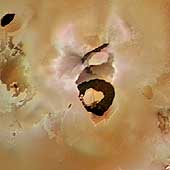 Loki Patera
Loki Patera
This is a close up view of Io's northern hemisphere.
The central feature has been named Loki Patera. The large dark
area might be a lake of liquid sulphur with a raft of solid sulphur
inside.
(Copyright Calvin J. Hamilton)
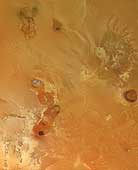 Venting Gasses
Venting Gasses
This photograph of Io shows what
appears to be a volcanic caldera that is venting gasses (the bright blue
patch at left center). In the photo is a network of volcanic calderas with
dark floors linked by bright red materials. The northernmost caldera has a
bright blue patch on the floor. Scientists believe the bright blue patch
may be clouds of gas issuing from volcanic vents. The gas clouds may
condense to form extremely fine particles that appear blue. Since
Voyager 1's
infrared spectrometer has discovered sulfur dioxide on Io, it is
possible that sulfur dioxide is the main component of the clouds. Sulfur
dioxide clouds would rapidly freeze and snow back to the surface. It is
also possible that dark areas in the floors of the calderas are pools of
molten sulfur, a very dark form of sulfur. The image was taken March 5,
1979, as Voyager 1 approached Io, and was taken from
129,600 kilometers (80,500 miles).
(Courtesy NASA/JPL)
 P3 Prometheus
P3 Prometheus
Voyager 1 took this picture of the P3 Prometheus volcano on March 4, 1979. The
volcanic eruption can be seen on the limb of Io.
(Credit: Calvin J. Hamilton)
 Ra Patera
Ra Patera
Ra Patera is a large shield volcano with multi colored flows. This image
shows at least a dozen dark flows originating from the central dark vent.
Some of these flows are 300 kilometers (186 miles) in length.
(Copyright Calvin J. Hamilton)


 Jupiter
Jupiter Thebe
Thebe Europa
Europa